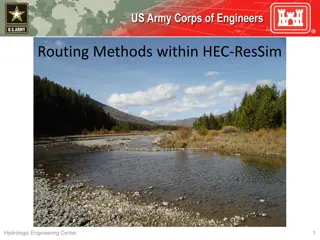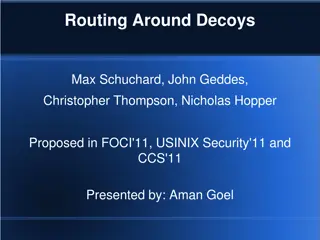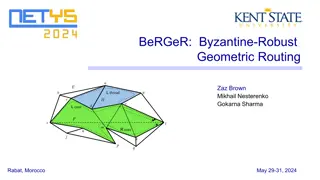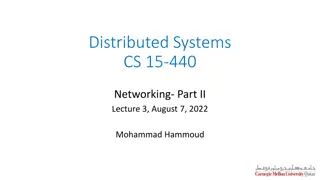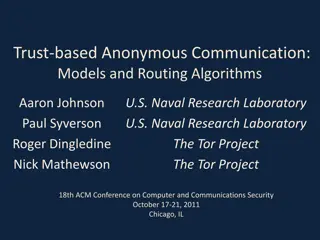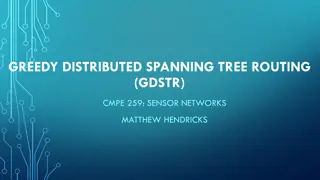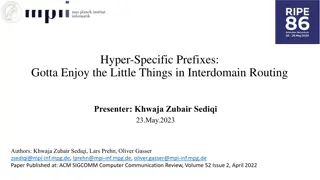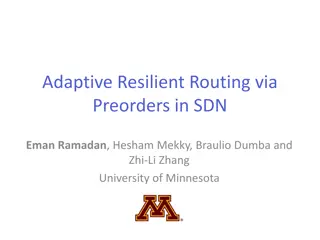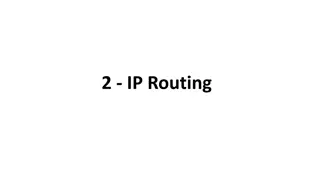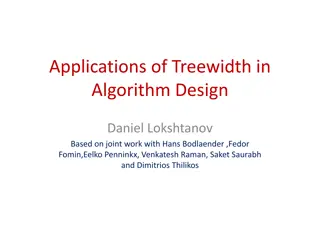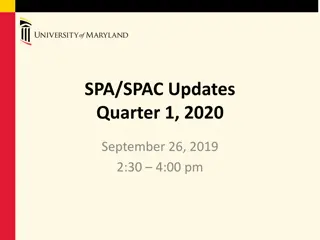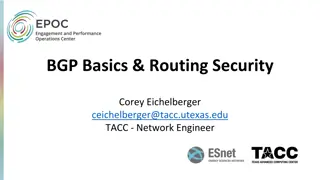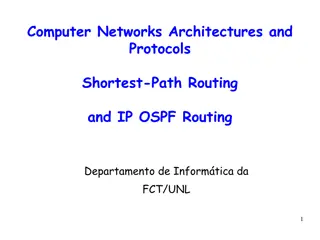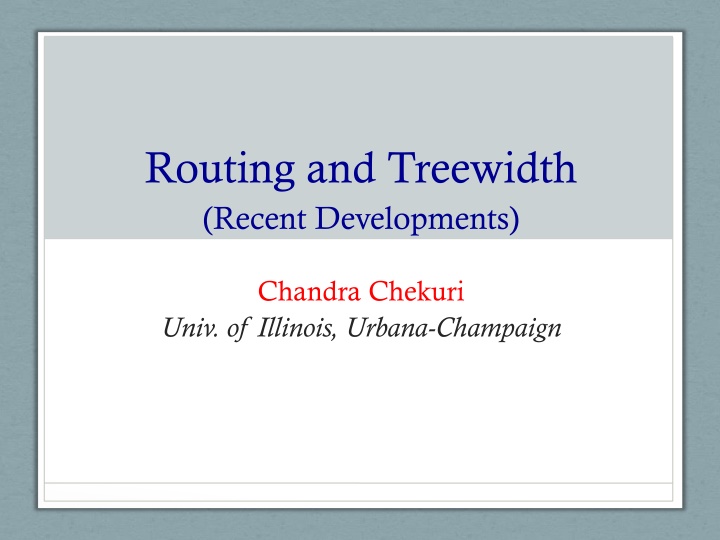
Recent Developments in Routing and Treewidth
Dive into the latest advancements in routing problems, treewidth complexities, decision versions, maximum throughput issues, hardness analyses, approximation methods, open problems, multicommodity flow relaxations, and integrality gaps. Explore the intricacies of connectivity, flow optimization, and algorithmic challenges in undirected graphs. Discover insights into edge-disjoint paths, node-disjoint paths, multiflows, and more, presented by experts in the field.
Download Presentation

Please find below an Image/Link to download the presentation.
The content on the website is provided AS IS for your information and personal use only. It may not be sold, licensed, or shared on other websites without obtaining consent from the author. If you encounter any issues during the download, it is possible that the publisher has removed the file from their server.
You are allowed to download the files provided on this website for personal or commercial use, subject to the condition that they are used lawfully. All files are the property of their respective owners.
The content on the website is provided AS IS for your information and personal use only. It may not be sold, licensed, or shared on other websites without obtaining consent from the author.
E N D
Presentation Transcript
Routing and Treewidth (Recent Developments) Chandra Chekuri Univ. of Illinois, Urbana-Champaign
Routing Problems Undir graph G=(V,E) and k node-pairs s1t1, s2t2, ..., sktk EDP: can all pairs be connected by edge-disjoint paths? NDP: can pairs be connected by node-disjoint paths? ANF: is there a multiflow for pairs s.t each pair has flow of one unit?
Hardness of Decision Versions NDP/EDP NP-Complete if k is part of input [Karp, Even-Itai-Shamir] EDP/NDP in P if k is fixed [Robertson-Seymour 90] ANF is in P via LP
Maximum Throughput Problems Undir graph G=(V,E) and k node-pairs s1t1, s2t2, ..., sktk MEDP: max # of pairs connected by edge-disj paths MNDP: max # of pairs connected by node-disj paths MANF: max # of pairs with flow of one unit
Hardness Undir graph G=(V,E) and k node-pairs s1t1, s2t2, ..., sktk MEDP: max # of pairs connected by edge-disj paths MNDP: max # of pairs connected by node-disj paths MANF: max # of pairs with flow of one unit MEDP/MNDP/MANF are (log1/2- n)-hard [Andrews-etal 05]
Approximation Undir graph G=(V,E) and k node-pairs s1t1, s2t2, ...,sktk MEDP: max # of pairs connected by edge-disj paths MNDP: max # of pairs connected by node-disj paths ANF: max # of pairs with flow of one unit MEDP/MNDP have O(n1/2)-approx [C-Khanna- Shepherd, Kolliopoulos-Stein] ANF has O(log2n) approx [C-Khanna-Shepherd 05]
Obvious Open Problem MEDP/MNDP/MANF are (log1/2- n)-hard MEDP/MNDP have O(n1/2)-approx Close the gap! No good relaxation for MEDP/MNDP
Multicommodity Flow Relaxation variable xifor each pair siti max xi s.t G supports multicomm. flow of xifor pair siti 0 xi 1
Integrality Gap for MEDP/MNDP tk tk-1 ti t3 t2 [GVY] (n1/2) gap t1 sk si s3 s2 s1 sk-1
Routing with Congestion Question: Is integrality gap small with congestion c? O(1) gap with O(log n/log log n) congestion via randomized rounding [Raghavan-Thompson 87] Main interest: constant c and c = 2
Recent Results [Chuzhoy 11] polylog(k) integrality gap for MEDP with congestion 14 [Chuzhoy-Li 12] polylog(k) integrality gap for MEDP with congestion 2 [C-Ene 13] polylog(k) integrality gap for MNDP with congestion 51
Work in Progress [C-Chuzhoy 14] polylog(k) integrality gap for MNDP with congestion 2 Corollary of stronger result polylog(k) integrality gap for ANF with node-capacities where unit flow for routed pair is half-integral Best we can hope for via flow relaxation
Rest of Talk Results follow from structural and algorithmic results on treewidth and well-linked sets Outline connections and recent results on treewidth
Well-linked Sets A set X V is well-linked in G if for all A, B X there are min(|A|,|B|) node-disjoint A-B paths G
Well-linked Sets A set X V is well-linked in G if for all A, B X there are min(|A|,|B|) node-disjoint A-B paths G
Well-linked Sets A set X V is well-linked in G if for all A, B X there are min(|A|,|B|) node-disjoint A-B paths No sparse node-separators for X in G B C A
Treewidth & Well-linked Sets A set X V is well-linked in G if for all A, B X there are min(|A|,|B|) node-disjoint A-B paths No sparse node-separators for X in G wl(G) = cardinality of the largest well-linked set in G tw(G) = treewidth of G wl(G) tw(G) 4 wl(G)
Treewidth and Routing [C-Khanna-Shepherd 05] Reduce integrality gap question to well-linked instances with polylog(k) loss G=(V,E) and terminal set X = {s1,t1,...,sk,tk} X is well-linked in G
Treewidth and Routing [C-Khanna-Shepherd 05] Reduce integrality gap question to well-linked instances with polylog(k) loss G=(V,E) and terminal set X = {s1,t1,...,sk,tk} X is well-linked in G Question: If tw(G) = k does G have a large routing structure?
Treewidth and Routing Question: If tw(G) = k does G have a large routing structure? [Robertson-Seymour-Thomas] If tw(G) = k and G is planar then G has a grid-minor of size (k) Grid minors are good routing structures.
Treewidth and Routing [Rao-Zhou 08] Idea for general graphs: Embed an expander using cut-matching game of [Khandekar-Rao-Vazirani 05]
Treewidth and Routing [Chuzhoy 11,Chuzhoy-Li 12] If tw(G) k then there is an expander of size k/polylog(k) that can be embedded into G with edge congestion 2 [C-Ene 13] If tw(G) k then there is an expander of size k/polylog(k) that can be embedded into G with node congestion 51 [C-Chuzoy 14] improve node congestion to 2
A Structural Result on Treewidth [C-Chuzhoy 13] Informal: Every graph has a path-of-sets-system as a subgraph and whose size depends on the treewidth.
C1 C2 C3 Cr h Each Ci is a connected cluster The clusters are disjoint Every consecutive pair of clusters connected by h paths All blue paths are disjoint from each other and internally disjoint from the clusters
C1 C2 C3 Cr Ci Interface vertex
C1 C2 C3 Cr Ci
C1 C2 C3 Cr Ci
C1 C2 C3 Cr Ci
C1 C2 C3 Cr Ci
A Structural Result on Treewidth [C-Chuzhoy 13] Theorem: If tw(G) k and h r19 k/polylog(k) then there G has a path-of-sets systems with parameters h, r. Moreover, a poly-time algorithm to construct it.
Applications From theorem on path-of-sets and additional ideas: Polynomial-sized grid-minor theorem Embedding expander of size k/polylog(k) with node-congestion 2 via cut-matching game Treewidth sparsifier
Robertson-Seymour Grid- Minor Theorem(s) Theorem: tw(G) f(k) implies G contains a clique minor of size k or a grid minor of size k
Robertson-Seymour Grid- Minor Theorem(s) Theorem: tw(G) f(k) implies G contains a clique minor of size k or a grid minor of size k Corollary (Grid-minor theorem): tw(G) f(k) implies G contains a grid minor of size k Previous best bound: f(k) = 2O(k2 log k) [Kawarabayashi- Kobayashi 12, Leaf-Seymour 12] tw(G) h implies grid minor of size at least (log h)1/2
Improved Grid-Minor Thm [C-Chuzhoy 13] Theorem: tw(G) k implies that G has a grid-minor of size (k ) where 1/98 o(1)
Treewidth Sparsifier [C-Chuzhoy 14] Let tw(G) = k. G has a subgraph H such that tw(H) k/polylog(k) max deg of H is 3 # of deg 3 nodes in H is O(k4) Poly-time algorithm to construct H given G
Directed Graphs Dir graph MEDP is (n1/2- ) hard [Guruswami etal] Even with congestion c problem is n (c) hard [Chuzhoy-Guruswami-Khanna-Talwar] Symmetric demands: 1. pairs are unordered 2. siti routed if (si,ti) and (ti,si) are routed
Directed Graphs with Symmetric Demands Symmetric demands: 1. pairs are unordered 2. siti routed if (si,ti) and (ti,si) are routed Conjecture: polylog(k) approx with constant congestion via LP feasible for MEDP/MNDP [C-Ene 13] polylog(k) integrality gap/approx for ANF with symmetric demands with O(1) congestion Connection to directed treewidth
Directed Treewidth Question: If G has directed treewidth k does it have a routing structure of size k/polylog(k) ?
Open Problems Improve Grid-Minor theorem parameters Similar results for directed treewidth? Several lower-level research questions

